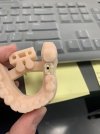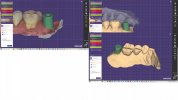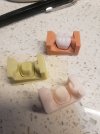GhostFake
Member
Full Member
- Messages
- 41
- Reaction score
- 0
We have done implant model work for years now, mostly printing them on our Formlabs 3B and for the most part we have not had many issues, until recently.
We have had a couple accounts that have complained about light/open contacts, specifically on implant cases, which usually end up in contact add-ons. But more recently we've been having a lot more issues and we are at a loss as to why they are happening. We just got one case back that in the mouth the mesial contact is open (they made some adjustments to get it to seat) but on our printed model the mesial contact is closed (see attached pictures) the case itself was scanned with a Primescan, using the Neodent Scanbody and designed in Exocad, using a Neodent Digital Analog and a Neodent Ti-Base.
But to make things even more baffling, we have one office that we've done implants for, digitally, for years. And in the last several weeks have had 3 different implant cases, with 3 different implant platforms, come back for remakes. What makes these cases so interesting is that the scanbodies they used were seated all the way but turned an impossible amount so the crowns wouldn't seat. (see attached pictures of the Straumann WN Variobase) the scanbodies were aligned correctly with the correct library, but the abutments were tweaked just enough that they needed to be redone. And a very similar situation happened with a Neodent case and a Neoss case using an Elos scanbody and Analog. Each of these cases were teaked just enough to be a problem when seated, and needed to be adjusted in the lab if not remade entirely. Anyone have any ideas what exactly could be the problem here? Or what we could possibly be screwing up on our end?
We've currently got a couple tests going on with our 3d printer to see if something funky is going on with our printer, but any ideas for trouble shooting would be much appreciated.
We have had a couple accounts that have complained about light/open contacts, specifically on implant cases, which usually end up in contact add-ons. But more recently we've been having a lot more issues and we are at a loss as to why they are happening. We just got one case back that in the mouth the mesial contact is open (they made some adjustments to get it to seat) but on our printed model the mesial contact is closed (see attached pictures) the case itself was scanned with a Primescan, using the Neodent Scanbody and designed in Exocad, using a Neodent Digital Analog and a Neodent Ti-Base.
But to make things even more baffling, we have one office that we've done implants for, digitally, for years. And in the last several weeks have had 3 different implant cases, with 3 different implant platforms, come back for remakes. What makes these cases so interesting is that the scanbodies they used were seated all the way but turned an impossible amount so the crowns wouldn't seat. (see attached pictures of the Straumann WN Variobase) the scanbodies were aligned correctly with the correct library, but the abutments were tweaked just enough that they needed to be redone. And a very similar situation happened with a Neodent case and a Neoss case using an Elos scanbody and Analog. Each of these cases were teaked just enough to be a problem when seated, and needed to be adjusted in the lab if not remade entirely. Anyone have any ideas what exactly could be the problem here? Or what we could possibly be screwing up on our end?
We've currently got a couple tests going on with our 3d printer to see if something funky is going on with our printer, but any ideas for trouble shooting would be much appreciated.







